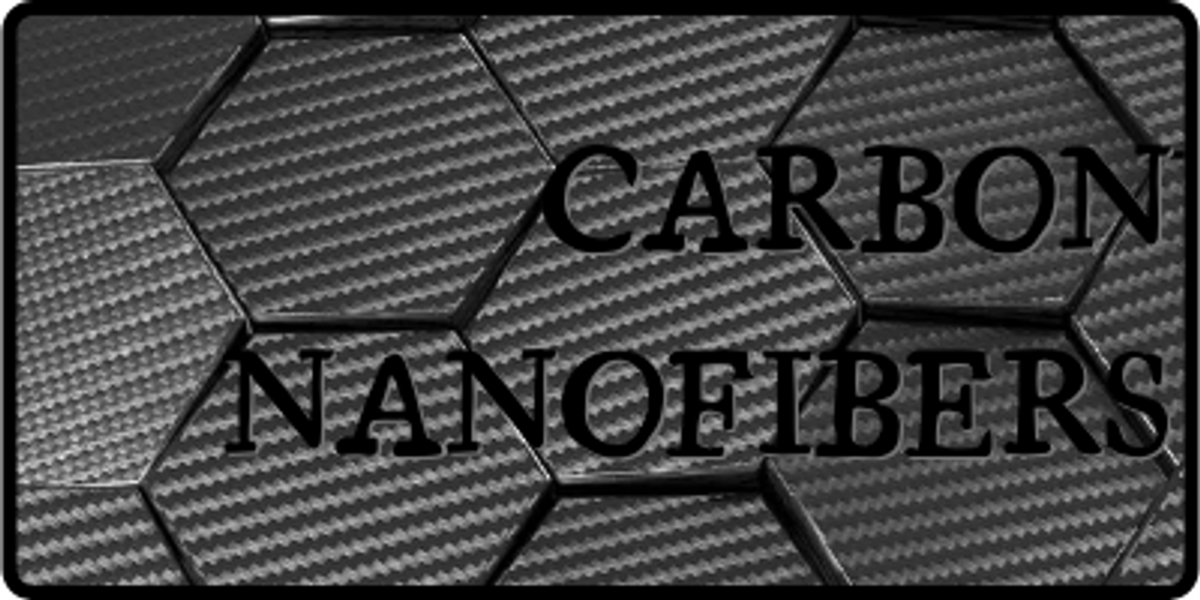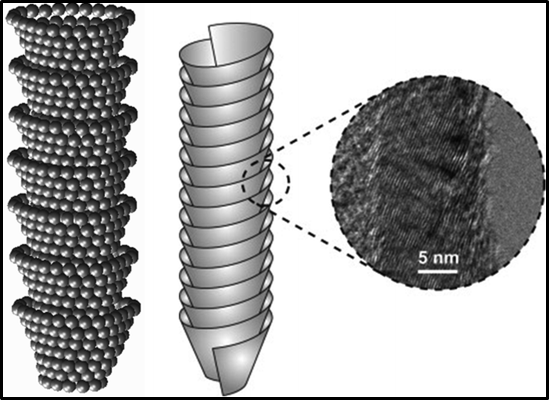Carbon Nanofiber (CNF)
Being investigated in scientific research and practical applications as one of the most important members of carbon fibers is Carbon Nanofiber (CNF). They are considered as promising materials in different disciplines like electrical and electronics devices, electrode material for batteries, supercapacitors and as the sensor. They are usually useful in application in which high electrical conductivity is required, which depends on the dispersion and percolation status in the matrix materials.
Carbon Fibers were first prepared by Thomas Edison in 1879 by the carbonization of cotton and bamboo strands for the conversion of energy and storage, sensing devices and reinforcement of composites, while in 1889, Hughes and Chamber dated a patent regarding filamentous carbon nanofiber through gas pyrolysis. The carbon nanofibers have a slight difference in structures as compared to the traditional carbon fiber. They are very versatile, famous for their mechanical, electromagnetic shielding, electrical and thermal stability with their existence at nanometer scale.
Let’s have a deeper look at its characteristics:
Properties of Carbon Nanofibers
The properties of the carbon nanofiber depend upon the structure of the carbon nanofiber, which relies on the technique of production and post-treatment techniques. Usually, carbon nanofibers are long, fibrous, platelet type of layers of carbon – arranged individually in layers perpendicular to the axis. The catalyst used decides the arrangement of the carbon nanofiber. The nanofibers have an average diameter of 50-200 nm with a single atom between 0.1 to 0.5 nm, hence require special, modern and microscopic techniques to study their properties.
Despite their microscopic size, they possess high mechanical and chemical properties. They have great dimensional stability maintaining the excellent thermal and electrical conductivities as they are thermally treated after various polymers undergo electrospinning. They also feature very low weight, ease of processing and shaping, and are resistant to corrosion with very high reinforcing capabilities. The numbers of defects decrease as the diameter of the fiber decreases, hence increasing the tensile strength of carbon nanofiber. The tensile strength of the carbon nanofibers varies inversely with the diameter of the fiber i.e. the tensile strength of carbon nanofiber increases as the diameter of the fiber decreases and vice versa. They exhibit very high flexibility. When the surface area/volume ratio is increased, it causes the increase in the area of contact between the polymer matrix and the filler, hence resulting in higher flexibility, which allows the fibers to maintain its ratio without bending or breaking. They also exhibit smoother and better finish due to smaller size of the fillers.
Carbon nanofiber has a low density of 1.3 – 2 g/cm3. The thermal conductivity ranges between 1950 – 6000 W/m K and electrical resistivity from 1 x 10-3 to 1 x 10-4. They have a tensile strength ranging from 2.92 to 500 GPa and tensile modules from 240 to 1500 GPa. The length of the carbon nanofiber can be up to 100 micrometers and average pore radius of 0.2 micrometers. The sonication of carbon nanofiber was completed for 20 s with output power of 120 W or 6 min for the power of 20 W. All the figures give the aspect ratio of 38 to the carbon nanofiber. The nested carbon nanofibers are stacked in parallel into different forms of structures or at an angle specified with reference from the axis of the fiber, causing a huge number of reactive edges inside and outside of the structure.
The compression-molded slab was used to measure the volume resistivity of the carbon nanofibers. To measure volume resistance, a programmable voltage source (Keithley 230) test fixture was deployed. Pressed samples were plugged into the four specified conductivity points of the apparatus. The observations and calculations were taken with a voltage of 500 V applied for highly resistive material (PEI) and composite materials with up to 3 phr of modified carbon nanofiber and 100 V for composite materials with 3 phr of modified carbon nanofiber.
High carbon nanofibers (CNFs) aspect ratio, strong adhesion, uniform distribution and good dispersion between polymer matrix and carbon nanofiber (CNFs) are the key factors to produce multifunctional carbon nanofiber (CNFs) and polymer composites reinforced with exceptional mechanical specifications. For the production of composites compounding, the most preferred method is that by melt mixing, enabling the function of carbon nanofibers (CNFs), feeding carbon nanofibers (CNFs) after melting the pellets of polymer, using a compatibilizer and/or avoiding mixing conditions, are important ways to accompany and facilitate the distribution and dispersion of carbon nanofibers (CNFs) and to maintain the high carbon nanofibers (CNFs) aspect ratio.
Mechanical properties of carbon nanofibers (CNFs)/composites of polymers are less than compared to the mechanical properties of CNT/composites of polymers. One of the reasons for it is the good intrinsic mechanical properties of CNTs over carbon nanofibers (CNFs). This indicates clearly that production of carbon nanofibers (CNFs) with upgraded mechanical properties is needed to formulate multifunctional carbon nanofibers (CNFs)/composites of polymer at lower filler loading. The best properties of tensile strength of carbon nanofibers (CNFs)/composites of polymer reported so far were for carbon nanofibers (CNFs)/PP composites produced by melt spinning. For composites produced by melt mixing and other such techniques, 10 of volume percentage of carbon nanofibers (CNFs) was required to increase the tensile strength by two times and tensile modulus. Due to the incompatibility between carbon nanofibers (CNFs) and polymer matrices, the functionalization of carbon nanofibers (CNFs) is an effective and required methodology to improve the interaction between the nanofiller and polymer matrix. There is very little literature on carbon nanofibers (CNFs)/polymer composites produced by grafted-carbon nanofiber (CNFs), melt spinning, solution processing, in situ polymerization and coagulation. Examining the properties of carbon nanofiber (CNFs)/polymer composite produced with one of these processes is important in order to unleash the reinforcement effect of carbon nanofiber (CNFs) and the ultimate properties that can be exhibited by their composites. Fortunately, great researches have been completed using CNTs and can be used as a guideline for future development with carbon nanofiber (CNFs).
Applications of Carbon Nanofibers
Carbon nanofibers have a variety of uses. They are being used by the researchers to deliver therapeutic drugs. An elastic material has been developed that is associated with carbon nanofibers resembling needles-like structures. The associated elastic material is supposed to be deployed as balloons which are inflated after inserting next tissue disease. Carbon nanofibers penetrate diseased cells when the balloon is inflated delivering the therapeutic drugs where required.
MIT researchers used carbon nanofibers to develop the electrodes of the lithium-ion battery that is capable of performing four times the overall storage capacity of present lithium-ion batteries. Technologists are even using carbon nanofibers to develop sensors that can indicate the absorption of the chemical vapors by changing color of their appearance. They ought to utilize the carbon nanofiber sensors to indicate the condition when the layer that absorbs and filter pollutants in a gas mask becomes saturated with the harmful elements or chemicals.
High reversible capacity, good cycle stability, and other electrochemical performance are a result of the unique and exclusive structure of the carbon nanofibers. This property of the carbon nanofiber comes very handy when they are used as electrodes for lithium-ion batteries that are capable of recharging.
The availability of the material at reasonable prices decides further market development in carbon nanofibers. The capacities of production in bulk of highly pure carbon nanofibers (CNFs) have been achieved by the researchers and scientists at very low cost using a process involving catalytic chemical vapor deposition (CCVD).
The stabilization and carbonization of carbon nanofibers after electrospinning polyacrylonitrile (PAN) has become an easy, convenient and obvious way to synthesis continuous and fibrous carbon nanofibers.
Field Emission (FE) and Electron Field Emission, more popularly known as Field Electron Emission, is an electrostatically induced emission of electrons. The emission of the field from a solid or liquid surface into vacuum is the most common context. However, the emission of field takes place when moving from a denser to less dense surface, low conducting dielectric or any non-conducting surface. The induction of field promotes electrons to conduction band from the valence band of semiconductors, which is also known as the Zener effect, which can also be referred as a form of emission of field.
The reproduction of the images of the surfaces using a physical probe used to scan the sample provided is called the Scanning Probe Microscopy (SPM). It is one of the branches of microscopy.
It is also used in the development of the carrier materials for the deployment of various catalysts in petrochemistry.
A platform for delivering gene in vertically aligned arrays. Impalefection delivers genes using nanomaterials including the materials as carbon nanofibers (CNFs), nanowires and carbon nanotubes (CNTs). Nanostructures resembling needles-like structures are perpendicularly synthesized to the substrate surface. The gene contained in plasmid DNA, meant for the intracellular delivery, is attached to the nanostructure surface. Many arrays containing these needles-like structures are kept in a chip, which is then pressed against cells or tissue, where required. The delivered gene(s) can be expressed by the cells that are impaled by carbon nanofibers or nanostructures.
The processes involving the manufacturing of composite material of a carbon-carbon consists of the steps of treatment with a catalyst material (containing metal), of a carrier material containing carbon. The metal must be able to form carbon structures of nano size and growing carbon structures of nano-size by deploying the deposition method of chemical vapor on the carrier, treated in an atmosphere containing carbon gas, optionally followed by a modification step for the surface. This process makes possible the optimization of hydrodynamical properties, surface chemistry and porosity independent from each other, which is especially beneficial in context of using the composite for purification of water. Black-based carbon composites are especially handy for the applications of filler.
Read: Role of Carbon Nanofiber in 3D Printing
Carbon nanofibers (CNFs) are one of the most dependable nanofillers used for many applications due to their multiple characteristics. Carbon nanofibers (CNFs) are produced when the hydrocarbon feedstock on a metallic catalyst is chemically vapor decomposed. Carbon nanofibers (CNFs) typically have a diameter of 50–200 nm and a length up to and around 100 μm. The Carbon nanofibers (CNFs) has a core that is hollow inside, made up of single or multiple layers of stacked parallel graphene planes, at a certain angle from the carbon nanofiber axis. The lower prices of carbon nanofiber (CNFs) in comparison to the respective fillers in competition such as CNTs, will be the major reason for their widespread commercial use in the industrial polymer. Carbon nanofibers (CNFs)/polymer composites possess good applications in many fields which include the following one mentioned: EMI SE, automotive industry, structural, sensors, ESD protection, and batteries. In addition to these, carbon nanofibers (CNFs) are good alternative to CFs and CBS.
Recent Posts
-
Cellulose Nanocrystals (CNC) in Food Industry
Cellulose nanocrystals (CNC) are emerging as a pivotal material in the realm of food technology, her …3rd May 2024 -
Reducing the Carbon Footprint of Nanomaterials
The production of nanomaterials is vital for numerous advanced applications, from healthcare to elec …26th Apr 2024 -
Nanocomposites in Food Packaging
The utilization of nanocomposites in food packaging represents a significant advancement in the fiel …19th Apr 2024







